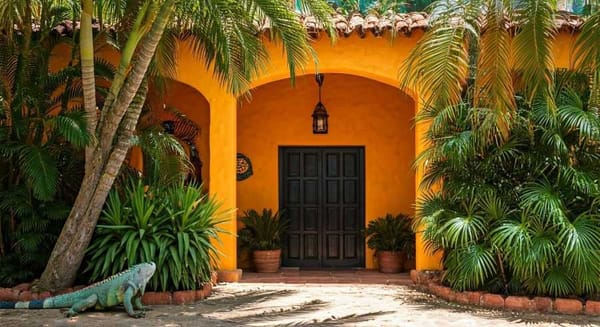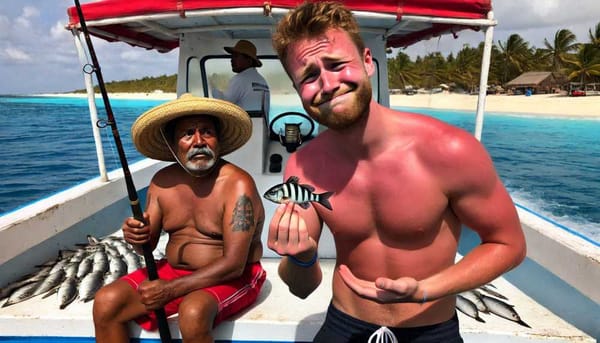Isla Holbox: The Local Food and Recipes of the Island
In Holbox, fish in tikin xiik', Maak kuum, seafood ceviche, and fried fish are the most frequently consumed dishes by tourists, non-native people who have come to work in Holbox, and the locals.

Fish in tikin xiik', Maak kuum, seafood ceviche, and fried fish are the dishes most frequently consumed on the island of Holbox by tourists and non-native people, or those who have come to work. The typical dish of Quintana Roo is fish a la Tikin Xiik'. The order of acceptance by island families is different; families prefer Maak kuum as the first option followed by fried fish and tikin xiik'.
Holbox also has local products. The most important are seafood products such as fish, mollusks, and crustaceans. This means that the culinary heritage is based mainly on these products. Vegetables are also grown on the island and protein products such as chicken, pork and beef can be found on the island, which complements the island's culinary heritage.
The island's culinary offerings are also an important factor in Holbox's culinary heritage. There are places to eat local dishes, although Las Panchas restaurant, according to most of the inhabitants, is the most emblematic place to know the local gastronomy, followed by Pizzeria Evelyn, where a culinary syncretism of Italian culture with local Quintana Roo products can be observed.
This is because a group of inhabitants of the island of Italian origin created the lobster pizza, and promoted it gastronomically for its commercialization and to make it popular on the island. Also in the restaurants, Playa Bonita, Las Pampas, and Viva Zapata local products are used, which could also help the economic development of the place.
Holbox has also suffered some loss of its culinary heritage. Several dishes are no longer consumed today, some because of the prohibition or ban to protect certain species of marine animals and others because of the negative effect of some of the factors mentioned above. Some products have totally or partially disappeared, or are only found in certain seasons.
Food is an important element that gives cultural identity to a place; however, it can be altered by the action of various intrinsic and extrinsic factors. The documentation of intangible cultural heritage, and specifically, gastronomy, will allow the preservation of this cultural wealth. Holbox has a culinary heritage that is the result of the syncretism of several cultures.
Burnt garlic broth
This recipe is originally from Holbox Island, the main ingredient being garlic, and the most outstanding technique is tatemar. Tatemar comes from the Nahuatl word tlatemati, which means to put over the fire to roast food. It is a technique for roasting or toasting food, usually over the comal or directly over the coals or as it is in the peninsula over firewood. The recipe was provided by Chef Luis Miguel Centeno.
Ingredients:
Head of garlic, chopped
Chopped garlic cloves
Green oil
Tomato
Oregano
Xcatic chile
Steak dressing
Pampino or Corvina
Water
Procedure:
Wrap the head of garlic in aluminum foil and put it to roast until it begins to burn, remove from heat and set aside. Fry the chopped garlic with the green oil until caramelized, set aside, and sieve. In the same pan fry the tomato, the xcatic, and the oregano set aside and sieve. Bring the water to a boil and add the fried and sieved garlic. Undo the steak dressing and add it to the broth. Once it comes to a boil add the burnt garlic and let it reduce for about 10 minutes. Add the fish for 5 minutes so that they do not fall apart and serve. Serve with habanero and lime.
Horse mackerel chilmole
The jack mackerel is a blue fish with a white belly, belonging to the Carangidae family. It is characterized by an elongated body measuring between 20 and 50 centimeters, with a very marked lateral line and a dark spot on the operculum (hard bone fin that covers and protects the gills). In various regions, it is known as "chicharrón" or "chicharrilla" depending on its size. It feeds on small fish, crustaceans and squid. It is prevalent throughout the year, however, the optimal season for its consumption is from April to October. Consuming it in chilmole is a luxury. Recipe originally from Holbox provided by Marta Etelvina Campos Moguel.
Ingredients:
Horse mackerel
Onion
Tomato
Deveined sweet chili
Butter
Crushed garlic head
Oregano
Red and black corn
Nixtamalized corn dough
Branch of epazote
Water
Dough
Salt
Procedure:
Roast the jack mackerel alone with salt over charcoal from one day before and refrigerate. Make a bouquet with the garlic and oregano and add to the water along with the epazote, bring the water to boil. In a frying pan put the lard and fry the onion, tomato, and sweet chili all chopped. Melt the ingredients in water and add to the fried vegetables, fry for about 4 minutes, and add everything to the broth. Melt the masa in a little water and add until you get a thick consistency like atole. Finally, cut the jack mackerel into the desired size and add it to the chilmole.
Fish Maak kuum
Original recipe from Holbox Island, delicious fish Maak Kuum, which can be substituted by fish such as grouper or snapper. It is often prepared in coastal restaurants such as Isla Mujeres, and Tulum, among others. This dish is visually characterized by the presence of achiote paste, the classic condiment of Peninsular cuisine. The recipe was provided by Chef Luis Miguel Centeno.
Ingredients:
Burnt garlic head
Pepper
Oregano
Tomatoes
Red onion
Tomato puree
Red cabbage
Sliced potatoes
Sea bass or cave spices
Procedure:
In a pot put the potato slices, tomato, onion, oregano, and pepper, and fry everything together for 4 minutes, stirring constantly. Add the tomato puree and sauté for a couple of minutes more. Put the grated and salted fish on top of the sautéed vegetables, cover the fish with water, break up the red recado and add it to the water. Sieve the burnt garlic and add it also when the water starts to boil, put on low heat for 30 minutes.
Horse mackerel pipian
Pipian is a sauce made with pumpkin seeds, depending on the additional ingredients, it can have red and green varieties. It is used for chicken or pork dishes, although currently on the coasts of Mexico it has been adapted for fish dishes. The recipe was provided by Marta Etelvina Campos Moguel.
Ingredients:
Horse mackerel
Water
Pepita for pipian. (pumpkin seed, toasted and ground).
Garlic head
Oregano
Tomato
Onion
Procedure:
Roast the jack mackerel with salt over charcoal a day before and set aside in the refrigerator. Boil water with garlic, onion, oregano, and tomato. Melt the pipian in water and with the help of a strainer add to the broth and boil until it begins to thicken. Cut the horse mackerel into the desired portions and add to the pipián.
Mullet roe pancakes
Roe is a large concentration of fish eggs. They are used in cooking many dishes, even raw. The mullet roe, which can be used fresh, although it is easy to find in the market slightly dried and salted. It is fried, peeled, and ground to powder, and then fried with egg, coriander, onion, and green chili. Recipe by Chef Luis Miguel Centeno.
Ingredients:
Dried mullet roe
Chopped onion
Chopped garlic
Chopped mint
Egg
Olive oil
Procedure:
Open the roe in half lengthwise and roast in charcoal over low heat. Once roasted, grind them with a grinder or in a blender. Once the smooth roe powder is obtained, add the onion, garlic, and mint, and add the egg little by little until a dough consistency is obtained. Be careful not to overdo the egg, otherwise, the pancakes will break. Shape the dough into pancakes. Heat the olive oil and fry the pancakes. Serve with fried chiltomate.
Sources: La Cocina Cotidiana de Quintana Roo by Manuel Isaías Pérez Alamilla




